
I didn’t intend on going down a rabbit hole this morning. Or at least, not this rabbit hole. I thought I was starting my day down a much narrower hole, to quickly and efficiently demonstrate that the Samsung Galaxy Watch5 Pro specs for thickness were woefully incorrect and misleading. That specific scavenger hunt was initiated by Reddit this weekend after watching my Early Review of the Samsung Galaxy Watch5 Pro, and noting there was no way the 10.5mm thickness listed for that watch was accurate, given the far more sleek/older Galaxy Watch Active 2 was listed at 10.9mm. It seemed impossible.
And sure enough, it was.
It wasn’t even close. The measured thickness of the Galaxy Watch5 Pro was ~15.2mm, some 50% thicker than the claimed 10.5mm spec. And the weight? More than double the spec. As apparently Samsung doesn’t include the band weight in their measurements (despite no caveats declared/listed).
At this point in my morning, I figured I’d just grab an Apple Watch and a Garmin watch, and then illustrate that both of those companies know how to use a ruler. Except, that journey ended shortly when I measured both watches and they too were thicker than spec, albeit, not by nearly as much as Samsung’s. Here, you can see the Apple Watch Series 7 at 13.1mm (claimed is 10.7mm), and the Garmin Forerunner 255 Music at 14mm (claimed is 12.9). I assume my margin of error is about 0.1mm using this tool.
So on and on down the list I went. First the Watch5 40mm, then the Watch5 44mm – both thicker than spec. Then I grabbed a Polar Pacer Pro (fatter than spec), a Suunto 9 Peak (chubbier than spec), and the Garmin Enduro 2 (plumper than spec). And finally, I grabbed the Fitbit Sense and the Wahoo Rival.
Holy cow! Finally, I’ve got two companies that know how to use a measurement tool. Both the Fitbit Sense and Wahoo RIVAL were exactly on-spec (within my margin of error).
I suspect for different reasons. In the case of Fitbit, they’ve always been pretty honest when it comes to spec-specific things. For example, battery life claims Fitbit is always very conservative, and battery life virtually always matches what they list (or is better than list). I might not agree with them on accuracy, but in terms of base specs, they get that right. And in the case of Wahoo, I suspect being their first Wahoo-branded watch, I suspect nobody simply told them they were supposed to lie about the thickness measurements.
So I then went down the path of trying to figure out what these exact specs were listing, and it turns out, they were listing the portion of the case excluding the optical HR sensor bump. If you measured everything except that, they all matched (except Samsung, more on that in a second). So if we look at the Garmin Forerunner 255 Music, its spec is 12.9mm, and measured at 12.93mm if I ignored the optical HR sensor bump. Same with the Apple Watch Series 7 (10.68mm measured vs 10.7mm).
On one hand, I get why a company might want to list it this way. In theory, said 1-2mm bump effectively ‘melts’ into the depths of your skin/wrist when you wear it. So the practical visible depth is everything except that. However, as much as I appreciate the creativity in that line of thinking, let’s be clear: It’s not true. Even more so since none of these companies list an asterisk there or other such documented caveat. Apple, Samsung, Garmin, and others all have plenty of caveats on their website around numerous other claims. But for this, they just ignore it (the same is true for the weight being pod-only, not including the band). Further, it makes it impossible to meaningfully compare the different watches, since companies like Wahoo and Fitbit are including everything – sensor bump (no matter how small) and all. I’m not philosophically opposed to including this measurement, but it needs to be caveated somewhere if it’s not the entire device thickness – just like every other caveat. After all, there are some people that actually *WANT* a thicker watch.
However, we need to step back to Samsung for a second. Because this wasn’t just a 1-2mm bump. This was a 5mm difference between spec and reality – a 50% increase in the stated thickness of the product. What the heck is Samsung measuring?
Well, turns out they’re just measuring the sidewall of the watch, that’s it. This ignores the entire back case, as well as the sensor bump. Their back case is a rounded hump that goes up 3mm, before then having the sensor bump rise from that another 2mm or so.
Mind you, this has changed with how Samsung used to measure watches in years past, which did previously include everything. And then Samsung took the apparent gentleman’s agreement of not measuring sensor bump to then not measuring any portion of the back of the case. The good news here is that Samsung’s at least consistent with their measuring inaccuracy, as based on their battery claims – my testing shows them significantly short there too.
But more on that later, thanks for reading!
FOUND THIS POST USEFUL? SUPPORT THE SITE!
Hopefully, you found this post useful. The website is really a labor of love, so please consider becoming a DC RAINMAKER Supporter. This gets you an ad-free experience, and access to our (mostly) bi-monthly behind-the-scenes video series of “Shed Talkin’”.
Support DCRainMaker - Shop on Amazon
Otherwise, perhaps consider using the below link if shopping on Amazon. As an Amazon Associate, I earn from qualifying purchases. It doesn’t cost you anything extra, but your purchases help support this website a lot. It could simply be buying toilet paper, or this pizza oven we use and love.

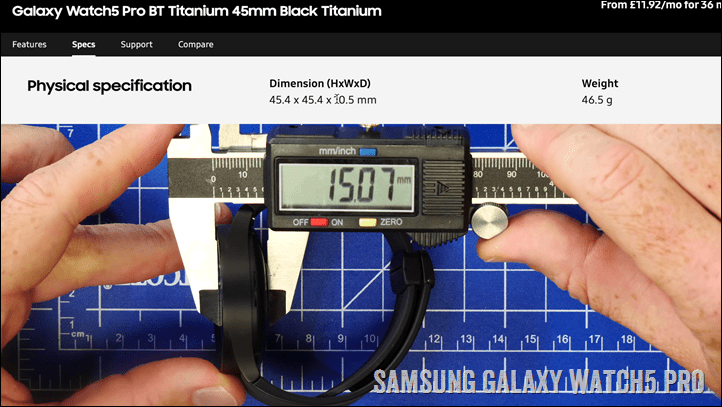
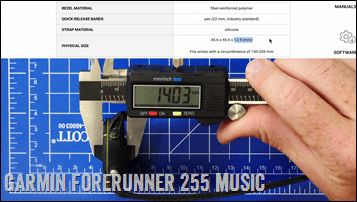
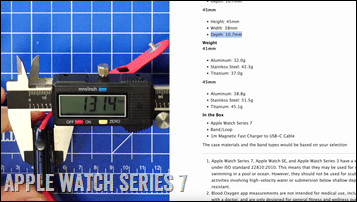
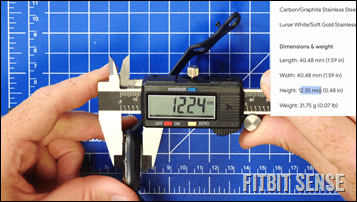
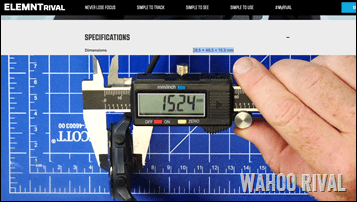
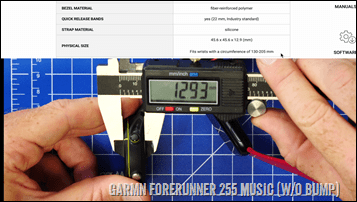
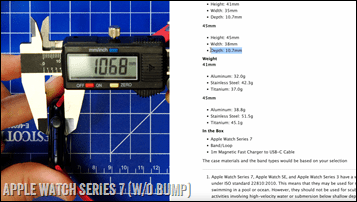
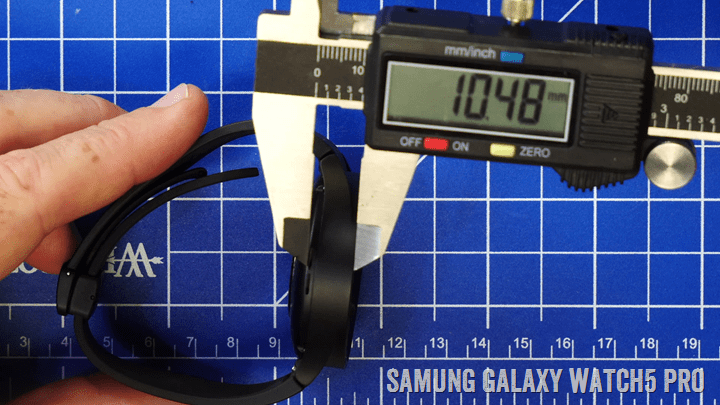

















Yup.
I expected the sensor bump caveat but the Samsung measurement is highly strange (I haven’t got one yet).
Yeah, I might go down a further rabbit hole to see exactly when companies started excluding the sensor bump. It definitely wasn’t always that way. I can see the Samsung S3 included it for example, as did many of Garmin’s previous gen watches.
FWIW, if you’d handed my calipers and asked me to tell you how thick one of these watches is, it would not even have occurred to me to include the sensor bump.
I’m not entirely sure why. It might be because the bump doesn’t add functional thickness, it might be because the bump is only a small protrusion from an otherwise uniformly thick puck, or it might be be because I’m used to reading about the thickness of regular mechanical watches, and because none of those have sensors, it seems that including the bump in the smartwatch thickness means you can’t do real apples to apples comparisons.
It does add thickness though. And if it’s deforming your skin noticeably, them you aren’t going to be keeping it that tight for long.
It also opens up it to abuse. It would cost these companies nothing to include measurements with and without the sensor bump too
I wish more manufacturers would understand that consumers would much rather be pleasantly surprised by better-than-advertised specs, than the opposite. Kind of seems like psychology 101.
I’d rather find out that my watch advertised as 14mm thick was actually 12mm, than 16mm.
That’s especially true for battery life – I’d rather find out that my watch advertised as having 48 hours of battery really lasts 60 hours, not 18.
I work in the luxury manufacturing industry, and our company has an official internal policy of “under-promise, over-deliver”; I think more companies should take a similar approach.
Feeling relieved that I’m not the only one. Was searching
for Watch 5 Pro weight with strap to compare to my 945 but it can’t be found. Didn’t even consider the height discrepancy.
I’m done looking at the watch now.
Samsung has a reputation for cheating on smartphone benchmarking tests, so its no surprise they’ll play fast and loose with the rules here too
link to arstechnica.com
I’m pretty sure I’ve got that same caliper.
No Coros measurement?
I had to press pause before my rabbit hole got even more dangerous. I’ll check COROS tomorrow and add it into post.
I had allocated 2.5hrs this morning to shoot/edit what I thought was going to be a 2-4 minute long video on just the Samgung Watch5 specs, then move onto other things. 6 hours later…
I got curious and measured my Pace 2. My micrometer isn’t as fancy as yours, it’s just an old manual one with no digital readout. I get 13.2mm with the bump and 11.2 without. Advertised spec is 11.7mm so well within the margin of error for a manually read micrometer for the thickness without the bump.
Out of curiousity, do you have the messurements for the galaxy watch 4 classic 46mm?
I bought a galaxy watch 5 pro and the thickness and weight are fine for me. With my order, i got a wireless duo charger but with the Dband, you can’t put it on the charger without having to take the band off. Saw a silicone charging stand on Amazon that you can insert the samsung magnetic charging puck into, and it keeps the watch cushioned. The stand works with galaxy watch 4 classic 46mm but I am not sure whether the watch 5 pro would be too big for the stand.
This makes the rolling pin and the Oreo tests mandatory going forward.
Marketing, at its finest. “Tell the truth, nothing but the truth, but never the whole truth.”
I read your post because I questioned Samsung’s thickness spec on my watch. Sure enough it was way lower than Samsung stated. That’s a shame they feel they have to lie about it.
How thick is a single-stuf oreo anyway?
Are screen diameters accurate?
I’ve measured at least 2 Garmins and 2 Polar diameters and the companies data are actually generous by about 1 mm. to 1.5 mm. But I didn’t include the buttons in the measurement.
This rabbit hole has one of those one-way doors you see in hotels that each of you have to unlock from your side. On the other side is a rabbit hole on how the entire watches pressure on your wrist is taken up by a 2.6mm wide HRM bump.
I ended up with an abrasion which meant switching wrists til the abrasion healed.
Anyone else with this issue?
(Fenix 7x)
I think many (almost all?) manufacturers cheat or document this intentionally in a misleading way. Ok, 10,5mm : 15,2mm is very bold. Of course, the manufacturers will always make excuses and have some flimsy arguments at hand and will apologize for the “misleading” information, if necessary…
A good example is the automotive industry: the normal consumer never achieves the fuel consumption stated there…(but the information corresponds to any prescribed statutory provisions).
For my F7xSS I measured 15,95mm : 14,9mm (Garmin specs). Ok, not much difference, but I am very sure, Garmin would have a “good” explanation for this…
The question is: housing thickness: does the sensor bump count as part of the housing? Is this regulated by law somewhere or is it a gray area and manufacturers are within the legal leeway?
Sorry, me again: one could then also question whether the buttons and the bridge brackets should not also count towards the case diameter…?
It will be much better to make purchasing decision online if it did.
In fact, considering the percentage of sales that happen online these days, we do need additional laws that mandate manufacturers to provide accurate specs, especially for higher value items. Actually, some people might find that ordering a regular sized burger that’s more like a junior burger when delivered rather offensive.
Yeah, to me it’s all very simple: What are the dimensions of the product?
I mean, it’s a very black-and-white issue. Nobody goes to a hardware store to get a 2×4 and is OK with it perhaps actually being 1.5×3.2.
[Update: Serves me right for trying to use a lumber analogy while not living in the US for a decade…]
Concurrently, I’m also actually OK with them deciding the sensor bump isn’t part of the measurement, as long as that’s specifically called out. I’m actually surprised Garmin, if all companies (a company known for being ultra-conservative when it comes to business and finance moves), would expose themselves this much legally speaking. The consumer laws in the EU and UK are really strict in this area, and without any listed caveats, it’s an easy claim for someone to make about false advertising or deception. Apple, Samsung, and others caveat far less nuanced things than this.
Have you ever measured a 2 x 4? Always small in both dimensions. At least here in the US.
link to popsci.com
Sigh…figures the one time I make a wood analogy…
Stick lumber has both a “nominal” dimension (i.e. 2×4, 1×2, 4×6) and and actual dimension.
2×4 = 1.5” x 3.5”
Not 100% sure on the origins, but I think they stem from 1. the fact that lumber shrinks after cutting due to water evaporation from the cells of the wood and 2. It’s easier to say.
It was a funny day in architecture school when the kids that didn’t know learned about this.
Im not understanding why this is such a big deal. I get the specs are wrong but the specs being wrong doesn’t effect the ability of the product to work. There are industries like wood working or home building where the specs are the most important because functionally it wouldn’t work. If it’s about the honesty of the company I could see it but there isn’t a truly honest company in existence. I wouldn’t see this holding weight in a court case because it wasn’t explicitly said what the measurement is.
If you want a green bike, but instead get a pink one, would you complain or would it be fine for you because it would work the same?
If a manufacturer starts lying about the soles/heel drop of running shoes, would it be fine for you because they are still running shoes or would you complain?
If Samsung thinks, that the thickness of a watch doesn’t matter, then they should not publish it. They also don’t have battery capacity and voltage in the spec sheet, or which CPU they use. So leave it out if you think it’s not important. But lying, even more when the numbers are off by that much, should be punished.
Yeah, distracting lumber analogies aside – where do we stop with lying?
As noted, the sensor bump isn’t a huge deal. But these companies list the specs for the watch pod (and weight). This isn’t some unlabeled spec. It shows height/length/width right above it on every company. Thus, I expect it to match what it says.
Just as I expect other features to match what’s declared.
FWIW: 2″ x 4″ (and so on) is the rough sawn dimension. The lumber mills plane 0.25″ off of each side to yield what we expect for a surface finish. Thus we buy nominal 1.5″ x 3.5″ boards.
Hahaha I really thought you make the 2×4 reference as a solid joke!
a 2 x 4 hasn’t been a 2×4 for years. I’m surprised you don’t know this.
oh the irony. Misleading claims are all around….even on review sites
I hate to break it to you, Ray, but a 2×4 is actually 1.5×3.5.
The sensor bump is a big deal though. Garmin made the sensor bump on the Fenix 7 thicker, possibly to make the watch “thinner”. As a result my Fenix 6 is way more comfortable than my Fenix 7 and accuracy seems identical. When they are offsetting one against another just for marketing claims about thinness and ignoring usability and comfort that feels like a big deal to me so glad you highlighted it.
Wouldn’t be hard to include overall dimensions as well as these imaginary ones for arbitrary parts of the device.
“I’m surprised you don’t know this.”
Yeah, I haven’t lived in the US for a decade, and thus, had a reason to buy a 2×4 in more than a decade…
It’s fairly common knowledge and has ZERO to do with living in the US. I’m well aware of where you live ( I also know you’ve been back to the US) multiple times. Nice try
It’s not common knowledge, your point of view is really self centric ;)
In Europe, most people wouldn’t even know what a 2×4 should be, because we use the correct system to measure things. If you go to a hardware store in Europe to buy wood, it is exactly the dimensions as they advertise it.
However, all this isn’t even the point, so why all those stupid comments? If US people are okay with wrong advertise claims, why did you sue Red Bull after realizing that you can’t really fly after drinking an energy drink? ;-)
Generally speaking, when I travel to the US these days, going to the lumber department of Home Depot isn’t really on my to-do list. Sorry to disappoint you (apparently in multiple ways).
Wow really? You guys use nautical miles to measure things? Or maybe you’re talking about Planck lengths? A.U.? Parsecs? (Hint: there is no “correct system”. French imperial units are not the “correct system”. Depends on what you’re doing.)
If we sued Red Bull, we’d have to sue Coors for telling us that if we drink Coors we’ll hallucinate gigantic people and trucks (or is it the other way around? It’s been a long time…). Or the endless commercials about 4WD vehicles driving around in deep snow. People believe them, and then I’m skiing past 4WD’s stuck in ditches up in Rothrock every winter.
So I just looked and Wikipedia actually has an article: link to en.wikipedia.org
Little do you know, Paul:
link to en.wikipedia.org
And yes, you sued Red Bull:
link to bettermarketing.pub
But then, you also sue McDonalds because coffee is hot:
link to en.wikipedia.org
Since we’re link-dropping. Here’s the aforementioned Red Bull lack-of-wings lawsuit: link to bettermarketing.pub
To his credit, he did win…
@Andreas, I’m well aware of SI. I’m a scientist, I have a Ph.D. in Physics. But I’m smart enough to use multiple different systems. Customarily I use US statute (defined by law in terms of SI) and the much more useful Fahrenheit rather than C, but in my work I use the appropriate units, so Kelvin for temperature, km for shorter distances (distance above Titan’s surface, for example), A.U. for solar system distances. In cosmology they use parsecs (not m) and solar masses (not gm). In high energy physics they use units such that \hbar=c=1 (so you don’t have to keep writing them), and everything is measured in units of energy (eV, not joules or ergs). As I said, it depends on what you’re doing, and SI is usually not the most convenient choice. And of course, nautical miles are used everywhere for aviation and shipping, because the nautical mile is 1 arc minute on the surface of the earth (unlike the meter, which was intended to be 10,000,000 between the equator and the pole but they botched it).
Respectfully, all of your examples are specialized units for esoterica, not everyday or even common engineering or scientific matters. If you reach hard enough you can make the case for FFF units in cases also.
As someone who had to learn SI as a child AFTER learning imperial, growing up through the transition in Canada (side note: said transition is still not complete due to the influence of the USnor am I grown up), and having worked in companies/industries which leaned either way, SI is superior in every way, including temperature (freezing to boiling / 100 makes way more sense than freezing at -32 boiling at 212).
Humans may be “ugly bags of mostly water” as they said on a ST:TNG episode, but we are self heated ugly bags of mostly water. 100F is body temperature (or at least it’s supposed to be, but it didn’t quite turn out that way). 0 F is (as you know in Canada) technically known as “f*cking cold”. In large parts of the US, negative temperatures F aren’t encountered (here in Central Pennsylvania, a few times a year). I’ve skied in -15 F, ridden in 115 F. 100 C is deadly, 0C is a little cold, and you guys need negative temperatures all winter (that’s why you should use Kelvin :-)). There’s no reason to tie temperature units for everyday living to the properties of pure water.
High energy physics isn’t esoterica (huge field), cosmology isn’t esoterica (somewhat smaller field), and neither is planetary science (smaller still, although we get a lot of pretty pictures). Units are chosen to be useful, not to be subject to the whims of some committee that doesn’t work in the field.
I knew a Kelvin, who was also a C.
It’s all about what you grew up with and are most used to.
You call Fahrenheit much more logical for humans, but all those temperatures in Fahrenheit have exactly zero meaning to me. Give me a Celsius temperature, and I immediately know what it means.
It’s kind of pathetic that we have those with doctorates in these comments proclaiming their way of measuring is better, when both are accurate.
I didn’t say it was better. Either works, but Fahrenheit is more convenient for someone who lives at mid-northern latitudes on a large continent. I object to the “correct system” guff that we get from the fans of the French imperial system. I know that 0C is 32F, that the forecast for the Vuelta is 30 C (so 86F, there are apps for that). My Withings scale has a mind of its own, so I weigh myself in pounds, kg, or stone depending on how it’s feeling. It’s easy to convert any of those to pounds. There’s no good reason not to use miles rather than meters (especially for cycling) and Fahrenheit rather than Celsius. I’m not boiling or freezing water at STP (and currently, where I sit at 1215 ft above msl, the boiling point of water is 98.93C rather than 100C). But the distance is the distance and the temperature is the temperature no matter what number you assign. SI isn’t (directly) used in many fields of physics. Even where sort of is, atomic physics uses Angstroms because it’s more convenient than saying 10^{-8} m all the time and they’ll use eV rather than 1.602177e-19 joules for energy because atomic transitions are generally eV scale . Units are chosen to be convenient for the situation.
You have to have >20 % body fat and a tight wrist band and the watch will be able to reduce your wrist diameter. So the watch dimension would be a negative dimension….
I was thinking on this trend since reading the article yesterday. I wonder if this started due to someone determining that thinner is better and figuring that the profile of the watch is what people think about when they consider the size of a watch. This could have been even based on feedback from focus groups when asking folks what they considered the important dimension. Once one company did it, then others mainly followed suit so that their devices compared favorably to their competitors.
And actually, I wonder if this started with the incorporation of the sensor because companies did not want their new watches to seem too big compared to their old (non sensor) ones? DC, any chance to look back at just one line of watches – perhaps the Garmin FR 9xx and see when this went from accurate to not? And in fact, I wonder how measurement was done when we had surface mounted buttons that were slightly raised. I bet that height was not counted on the FR 305 (which given it had a sloped shape adds another complexity to what is the thickness).
The band weight lack of inclusion I bet is something that started to be ignored once interchangeable bands became options.
Of course, this all should be noted in the specs as pointed out throughout the article and comments.
I can see that this rabbit hole is deep!
I think it’s easiest to see when you take a look at the fenix lineup, since 3 vs 3 HR is pretty much the same watch with only the HR sensor added. That increased thickness by 2mm as by Garmin’s spec. fenix 6 then suddenly was much thinner than the fenix 3 HR according to spec, however that is not the case and the difference is only very marginal as can be seen in the video very briefly.
link to garmin.com
link to garmin.com
link to garmin.com
link to garmin.com
link to garmin.com
link to youtu.be
TL;DR: Garmin did include the sensor bump until fenix 5 Plus; since fenix 6 they don’t measure it anymore.
That’s a very interesting detail observation! Almost suggests a very specific cause like “the Apple Watch happened”
Happens with a lot of tech, phone companies also don’t include the camerabump (or at least they didn’t a few years ago).
The thing that intrigues me most about this is… why? I can understand with things like smartphones where specs become a marketing game of Top Trumps (our phone is best because it’s 0.5mm thinner!), but what do Garmin, Polar, Suunto et al have to gain from this? Yes, obviously size is a factor in buying decisions, but I’d suspect that decision is going to be made based on how the watch physically looks, not the measurements on the spec sheet. I just can’t see under-reporting case depth by 2mm on a spec sheet being the difference between a sale or a loss to a competitor. So why are manufacturers exposing themselves so blatantly?
“So why are manufacturers exposing themselves so blatantly?”
Yeah, I agree here. Especially since this is such easy pickings for a consumer rights advocate to claim false advertising. And especially when many countries, notably in Europe, have very strict laws on this.
All it would have taken was an asterisk that size didn’t include sensor bump. Or, just simply include it. Like you said, nobody really cares about an extra 0.9mm or what-not. Now, 50% of the case size as is the case with the Samsung Watch5 Pro…that might be a bit different.
I think this comes from the wrong understanding that a wrist-computer is the same than a wrist-watch! Look at the Apple Watch: The more they try to stay slim the worse is the battery capacitiy. So all manufacturers use more or less legal tricks to get to an acceptable ratio ‘hight to diameter’. But in the end all smart/sport watch companies have to choose between a clunky form factor or a bad akku. The tech isn’t ready for real good looking wrist-computers today!
As mentioned above, according to Andreas Garmin didn’t always exclude HR bumps (and at a time when HR bumps were far more pronounced!), and the change happened when the Apple Watch was new. Back then the web was buzzing with armchair buying decisions, people declaring winners without ever seriously considering a purchase. Spec sheet millimeters mattered a lot.
Wow…cutting edge article. Content seems a bit thin on the ground these days and scrapping the barrel with watch thickness.
I don’t usually put much value in comments that come from e-mail addresses listed as:
“voinweovinowenvoiwnevoinewvoiew@nvidnvidnv.com”
I’d assume you are either a Samsung fanboy or perhaps Samsung’s PR team. But given I got an e-mail from them this afternoon, I’m just going to go with fanboy.
Ultimately, I’ve got more products than ever in the queue right now, and working on plenty of things. This is what people were asking about over the weekend, so it’s the rabbit hole I accidentally went down. Some 60K people have watched the video on YT (with extremely high like/watch-time ratios), and double that here on the site, in the last 48hrs. So obviously, there’s considerable interest in this – despite it apparently being the bottom of the barrel.
Can you check the back panel weight of the COROS at least?
So the COROS Vertix 2 has claimed depth of 15.7mm. However, when I measure it, it has a measured depth of 16.5mm (+/- 0.1mm).
If I measure as close as I can to the sensor bump (before it bumps), I get 15.8mm. Thus, they follow some with excluding their sensor, but don’t go quite as far as Samsung by excluding the entire back bump of the watch.
Wow… Did you already receive some feedback from manufacturers?
Indeed…already in discussions with a few of them on how to better display these stats (namely, just caveat the darn thing).
9to5google used your images with no attribution.
link to 9to5google.com
Too bad there are so many trolls in the comments. I found the information useful and appreciate you providing it at no cost to your readers. Your reviews and videos are very thorough and I appreciate your analysis. I never buy a new watch without reading your articles and watching your vids. Thanks for doing it!
While I agree that this is a bad thing,
most watch producers would be well off to simply specify that the sensor bulge is not included. Adding a disclaimer (that the sensor is usually somewhat pushed into the skin) would be fine for me.
What would really bug me (and you thankfully measured that as well) is weight differences:
I have very slender arms and weight differences would influence most of my purchase decisions.
Please please bug Garmin, Apple and others to be more precise about that… it’d really help (me).
Thanks!
I really think the caveat part is the only point here.
I really sort of agree with measuring thickness without the sensor bump – what I (and I think most users – if maybe not most consumers, which is the same people but in a different and more belligerant category) value is the functional thickness of the watch. Can it fit under a shirt? Will it get stuck when putting on my backpack?
And from that perspective, I’ve noticed the claimed spec is much more relevant, because the sensor bump disappears into the skin and therefore what they list is in fact the additional thickness on your wrist.
But yeah, it should be mentioned.
The headline got my attention there, but now that I’ve read a bit more about it I can understand why they don’t include the optical sensor bump – it kind of makes sense.
If you ask me: in which rectangular box “Epix Gen 2” will fit, I will say that: 54.0 x 49.4 x 16.0 mm.
But Gamin say that: 47 x 47 x 14,5 mm. :D
We use those calipers at work. I design very small radio circuits.. my current board has a max component height of 2mm, and every fraction of a mm counts. Even the cheap calipers are much more accurate than 0.1mm in practice.
Given your good work here, I can see the DCrainmaker “what size/weight is that watch” lookup tool appearing.
It will definietly be one of the more popular tools on this site.
I have a Suunto 7 and according to their website it’s 15.3mm thick. I noticed that my Garmin 645, which is officially only 13.5mm, is actually slightly higher on my wrist. It seems that the Suunto measurement includes the lugs which protrude about 2mm past the heart rate sensor. As the lugs wrap around my wrist the actual watch body is effectively only about 13mm thick. (Hope that makes sense) So this is an example of a manufacturer’s specs giving the impression that the watch is thicker than it actually is!